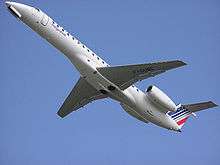Climb (aeronautics)

In aviation, a climb is the operation of increasing the altitude of an aircraft. It is also the logical phase of a typical flight (the climb phase or climbout) following takeoff and preceding the cruise. During the climb phase there is an increase in altitude to a predetermined level.[1]
Climb operation
A climb is carried out by increasing the lift of airfoils (wings) supporting the aircraft until their lifting force exceeds the weight of the aircraft. Once this occurs, the aircraft will climb to a higher altitude until the lifting force and weight are again in balance. The increase in lift may be accomplished by increasing the angle of attack of the wings, by increasing the thrust of the engines to increase speed (thereby increasing lift), by increasing the surface area or shape of the wing to produce greater lift, or by some combination of these techniques. In most cases, engine thrust and angle of attack are simultaneously increased to produce a climb.
Because lift diminishes with decreasing air density, a climb, once initiated, will end by itself when the diminishing lift with increasing altitude drops to a point that equals the weight of the aircraft. At that point, the aircraft will return to level flight at a constant altitude.
However, during a constant rate climb at a reasonably steady angle the lift force is generally less than the weight with the engine operating. This is due to the upward fraction of the thrust vector. This in turn causes the load factor to be slightly less than 1. It is only during the radial (constant increase in pitch) or vertical acceleration that the lift vector is larger than the weight vector.
Climb phase

The climb phase, also known as climb out, of a typical flight of an aircraft is the period during which the aircraft climbs to a predetermined cruising altitude after take-off. Depending on the aircraft, the altitudes involved, and other factors, this phase may last from a minute or two to half an hour or more. The climb phase immediately follows take-off and precedes the cruise phase of the flight. Although a single climb phase is typical, multiple climb phases may alternate with cruise phases, particularly for very long flights in which altitude is increased as the weight of fuel aboard decreases (see step climb).
During long climbs the angle or rate of climb is often reduced. This slows the speed of ascent but increases the speed of forward progress towards the destination. A gradual climb improves forward visibility over the nose of the aircraft and decreases wear and tear on engines that rely on air cooling.
If an aircraft exceeds its critical angle of attack, in a climb or otherwise, the wings may stall.
Aircraft also climb by entering a zone of rising air, but since such zones are unpredictable and inconveniently located, and since most are poorly adapted to passive climbs of this type, only gliders attempt such climbs on a regular basis. A passive climb combined with an active climb can produce a higher climb rate than either method alone.
The opposite of a climb is a descent.
“Normal” climb
In some jurisdictions and under some conditions, “normal” climbs are defined by regulations or procedures, and are used to develop airway systems, airspaces, and instrument procedures. Normal climbs are simply standardized climb rates achievable by most aircraft under most conditions that are used as conservative guidelines when developing procedures or structures that are partially a function of such rates. For example, a normal climb of 120 feet per nautical mile might be assumed during the development of a navigational procedure or while defining airspace limits in airport terminal areas.